Traditional processing
Preservation Methods and Processes
Both ripe and unripe bananas and plantains are normally peeled and sliced before
drying, although banana figs are sometimes prepared from whole ripe fruit. Sun drying
is the most widespread technique where the climate is suitable but drying in ovens
or over fires is also practiced. In West Africa, plantains are often soaked and
sometimes parboiled before drying. The slices of unripe fruit are normally spread
out on bamboo frameworks; or on a mat; or on a roof; or sheets of corrugated iron.
- Potential for scaling up of traditional processes
to industrial level
Many banana products are now produced on an industrial scale, including the traditional
banana figs and flour, and the processing techniques are described below. One of
the main problems encountered has been the susceptibility of banana products to
flavour deterioration.
The production of beer from banana and plantains has not been scaled up to an industrial
level, and while an important product in localised areas of tropical Africa, the
market is rapidly declining in favour of European-type brews produced locally.
Source:http://www.fao.org/docrep/V5030E/V5030E0O.HTM#8.7.%20Fruit%20juice%20technologies
Industrial processing
Processing technology
In general, to obtain a good-quality product from ripe-bananas the fruit is harvested
green and ripened artificially under controlled conditions at the processing factory.
After ripening, the banana hands are washed to remove dirt and any spray residues,
and peeled. Peeling is almost always done by hand using stainless steel knives,
although a mechanical peeler for ripe bananas has been developed, capable of peeling
450 kg of fruit per hour (Banana Bulletin, 1974).
The peeling of unripe bananas and plantains is facilitated by immersing the fruit
in hot water. For example, immersion in water at 70-75°C for 5 min has been
suggested as an aid for peeling green bananas for flour production, while the peeling
of green bananas for freezing has been facilitated by immersion in water at 93°C
for 30 min.
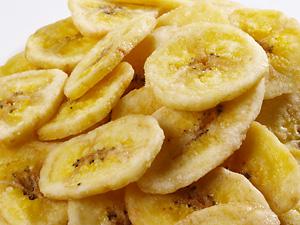
|
Fully ripe fruits with a sugar content of about 19.5% are used and are treated with
sulphurous acid after peeling, then dried as soon as possible afterwards. Various
drying systems have been described using temperatures between 50 and 82°C for
10 to 24 h to give a moisture content ranging from 8 to 18% and a yield of dried
figs of 12 to 17% of the fresh banana on the stem.
One factory in Australia uses a solar heat collector on the roof to augment the
heat used for drying bananas. Bananas can also be dried by osmotic dehydration,
using a technique which involves drawing water from 1/4-in. thick banana by placing
them in a sugar solution of 67 to 70 deg. Brix for 8 to 10 h. followed by vacuum-drying
at 65 to 70°C, at a vacuum of 10 mm Hg for 5 h. The moisture content of the
final products is 2.5% or less, much lower than that achieved by other methods.
|
TOP
|
Banana purée is obtained by pulping peeled, ripe bananas and then preserving
the pulp by one of three methods: canning aseptically, acidification followed by
normal canning, or quick-freezing.
The bulk of the world's purée is processed by the aseptic canning technique.
Peeled, ripe fruits are conveyed to a pump which forces them through a plate with
1/4-in. holes, then onto a homogeniser, followed by a centrifugal de-aerator, and
into a receiving tank with 29in. vacuum, where the removal of air helps prevent
discoloration by oxidation.
The purée is then passed through a series of scraped surface heat exchangers
where it is sterilised by steam, partially cooled, and finally brought to filling
temperature. The sterilised purée is then packed aseptically into steam-sterilised
cans which are closed in a steam atmosphere.
|
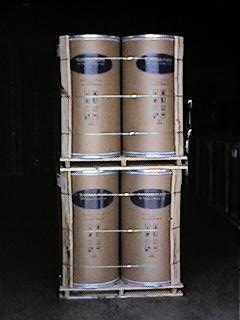
|
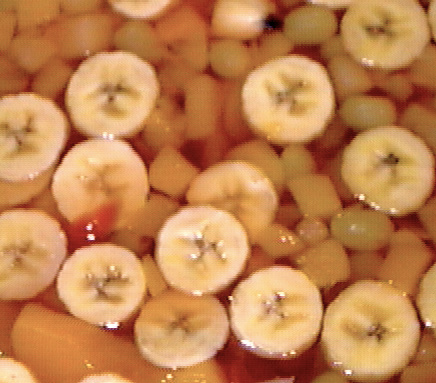
|
Several methods for canning of banana slices in syrup are used. Best-quality slices
are obtained from fruit at an early stage of ripeness. The slices are processed
in a syrup of 25 deg. Brix with pH about 4.2, and in some processes calcium chloride
(0.2%) or calcium lactate (0.5%) are added as firming agents.
A method for producing an intermediate-moisture banana product for sale in flexible
laminate pouches has been developed. Banana slices are blanched and equilibrated
in a solution containing glycerol (42.5%), sucrose (14.85%), potassium sorbate (0.45%),
and potassium metabisulphite (0.2%) at 90 deg. C for 3 min. to give a moisture content
of 30.2%.
|
TOP
|
In the manufacture of banana powder, fully ripe banana pulp is converted into a
paste by passing through a chopper followed by a colloid mill. A 1 or 2 % sodium
metabisulphite solution is added to improve the colour of the final product. Spray-
or drum-drying may be used, the latter being favoured as all the solids are recovered.
A typical spray dryer can produce 70 kg powder per hour to give yields of 8 to 11%
of the fresh fruit, while drum-drying gives a final yield of about 13% of the fresh
fruit. In the latter method the moisture content is reduced to 8 to 12 % and then
further decreased to 2 % by drying in a tunnel or cabinet dryer at 60° C.
|
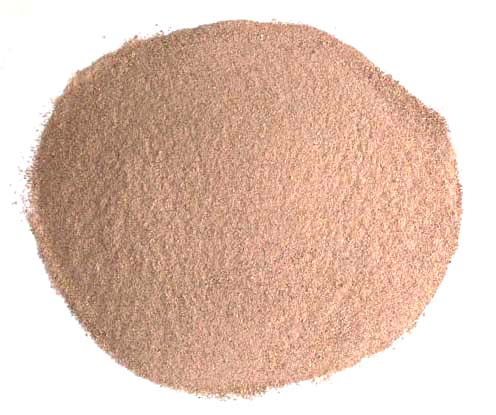
|
Production of flour has been carried out by peeling and slicing green fruit, exposure
to sulphur dioxide gas, then drying in a counter-current tunnel dryer for 7 to 8
h. with an inlet temperature of 75°C and outlet temperature of 45°C, to
a moisture content of 8%, and finally milling.
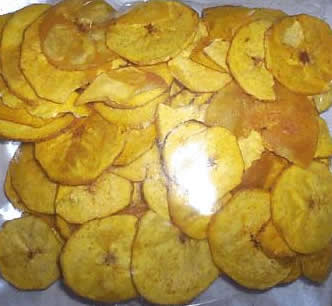
|
Typically, unripe peeled bananas are thinly sliced, immersed in a sodium or potassium
metabisulphite solution, fried in hydrogenated oil at 180 to 200°C, and dusted
with salt and an antioxidant.
Alternatively, slices may be dried before frying and the antioxidant and salt added
with the oil. Similar processes for producing plantain chips have been developed.
|
TOP
In a typical process, peeled ripe fruit is cut into pieces, blanched for 2 min in
steam, pulped and pectolytic enzyme added at a concentration of 2 g enzyme per 1
kg pulp, then held at 60 to 65° C and 2.7 to 5.5 pH for 30 min.
In a simpler method, lime is used to eliminate the pectin. Calcium oxide (0.5%)
is added to the pulp and after standing for 15 min. this is neutralised giving a
yield of up to 88% of a clear, attractive juice. In another process banana pulp
is acidified, and steam-blanched in a 28-in Hg vacuum which ensures disintegration
and enzyme inactivation. The pulp is then conveyed to a screw press, the resulting
purée diluted in the ratio 1:3 with water, and the pH adjusted by further
addition of citric acid to 4.2 to 4.3, which yields an attractive drink when this
is centrifuged and sweetened.
|
A small amount of jam is made commercially by boiling equal quantities of fruit
and sugar together with water and lemon juice, lime juice or citric acid, until
setting point is reached.
|
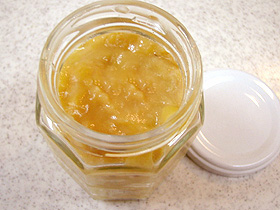
|
TOP
Product stability and spoilage problems
All dried banana products are very hygroscopic and susceptible to flavour deterioration
and discoloration, but this can be overcome to some extent by storing in moisture-proof
containers and sulphiting the fruit before drying to inactivate the oxidases.
The dried products are also liable to attack by insects and moulds if not stored
in dry conditions, although disinfestation after drying by heating for 1 h to 80°C
ensures protection against attack. Banana powder is said to be stored for up to
a year commercially and flakes have been stored in vacuum-sealed cans with no deterioration
in moisture, colour or flavour for 12 months.
Banana chips tend to have a poor storage life and to become soft and rancid. However,
chips treated with an antioxidant have been stored satisfactorily at room temperature
in hermetically sealed containers up to 6 months with no development of rancidity.
Quality Control Methods
In general a good quality product is obtained if fruit is harvested at the correct
stage of maturity and, where appropriate, ripened under controlled conditions. For
example, in the case of banana figs, the fruit should be fully mature (sugar content
of 19.5% or above) or the final product is liable to be tough and lacking in flavour.
However, if over-ripe fruit is used, the figs tend to be sticky and dark in colour,
so the fruit must be fully yellow but still firm.
For banana flour, which is prepared from unripe bananas, the fruit is harvested
at three-quarters the full-ripe stage and is processed within 24 hr. prior to the
onset of ripening. If less mature fruit is used, the flour tastes slightly astringent
and bitter due to the tannin content. Bananas harvested between 85 and 95 days after
the emergence of the inflorescence, with a pulp-to-peel ratio of about 1.7, were
considered to be most suitable for the deep-fat frying.
Other criteria suggested for assessing maturity were beta-carotene and reducing
sugar content, both of which increase with increasing maturity and pH which decreases
as the fruit ripens, and these should be, respectively, about 2000 µg/100
g, less than 1.5% and 5.8 or above. Browning was found to occur if the sugar content
was higher than 1.5%. The determination of crude fat in processed chips is also
considered to be a necessary quality control measure.
It is important to remove all impurities prior to processing of products, and this
is done by washing to remove dirt and spray residues and control on the processing
line so that substandard fruit can be removed.
Source: http://www.fao.org/docrep/V5030E/V5030E0O.HTM#8.7.%20Fruit%20juice%20technologies
Top
|